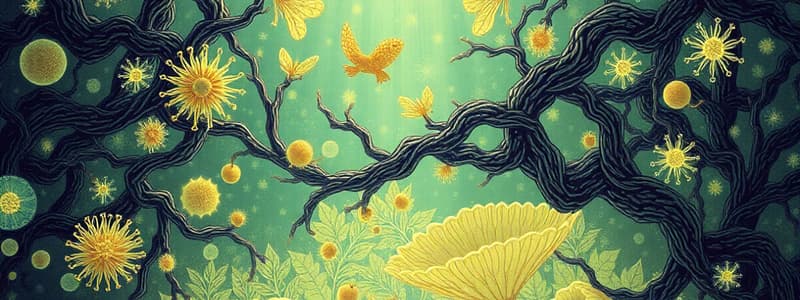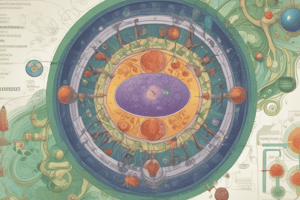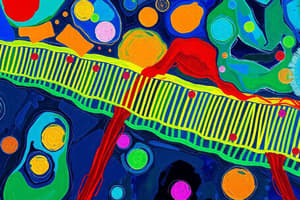Podcast
Questions and Answers
What is a key function of biological membranes?
What is a key function of biological membranes?
- To facilitate protein synthesis
- To provide rigidity to the cell
- To serve as a source of energy
- To act as a barrier to the outside world (correct)
Why must membranes be selectively permeable?
Why must membranes be selectively permeable?
- To prevent any substances from entering the cell
- To maintain a constant volume of the cell
- To allow waste products to build up inside
- To enable nutrient entry and waste removal for survival (correct)
What type of molecules face difficulty crossing the lipid bilayer?
What type of molecules face difficulty crossing the lipid bilayer?
- Hydrophilic molecules and larger ions (correct)
- Gases like oxygen and carbon dioxide
- Small non-polar molecules
- Membrane proteins
What does the fluid mosaic model describe?
What does the fluid mosaic model describe?
What are the polar and non-polar components of a phospholipid?
What are the polar and non-polar components of a phospholipid?
What characterizes a hypotonic solution?
What characterizes a hypotonic solution?
What happens to a cell in a hypertonic solution?
What happens to a cell in a hypertonic solution?
What is the nature of an isotonic solution in relation to a cell?
What is the nature of an isotonic solution in relation to a cell?
Which process describes the diffusion of water across a selectively permeable membrane?
Which process describes the diffusion of water across a selectively permeable membrane?
What type of molecules typically undergo diffusion through the cell membrane?
What type of molecules typically undergo diffusion through the cell membrane?
What is the primary source of energy for chemoautotrophs?
What is the primary source of energy for chemoautotrophs?
Which of the following organisms are classified as photoheterotrophs?
Which of the following organisms are classified as photoheterotrophs?
What type of organism utilizes the tissues and fluids of a live host?
What type of organism utilizes the tissues and fluids of a live host?
What role does the cell membrane play in nutrient uptake?
What role does the cell membrane play in nutrient uptake?
What is the first step in nutrient utilization by cells?
What is the first step in nutrient utilization by cells?
What is one of the major obstacles for cells during nutrient uptake?
What is one of the major obstacles for cells during nutrient uptake?
In which category do fungi fit based on their nutrient acquisition method?
In which category do fungi fit based on their nutrient acquisition method?
What is a key characteristic of chemoheterotrophs?
What is a key characteristic of chemoheterotrophs?
What characterizes the phospholipids in the plasma membrane?
What characterizes the phospholipids in the plasma membrane?
Which type of molecules can easily interact with the plasma membrane's outer face but struggle to pass through its hydrophobic core?
Which type of molecules can easily interact with the plasma membrane's outer face but struggle to pass through its hydrophobic core?
Why can't ions like sodium and potassium cross membranes by simple diffusion?
Why can't ions like sodium and potassium cross membranes by simple diffusion?
What role do glycoproteins play in the plasma membrane?
What role do glycoproteins play in the plasma membrane?
What is a characteristic of passive transport?
What is a characteristic of passive transport?
What is facilitated diffusion?
What is facilitated diffusion?
Which of the following methods requires cellular energy?
Which of the following methods requires cellular energy?
Which statement about diffusion is true?
Which statement about diffusion is true?
What is diffusion?
What is diffusion?
What drives the process of diffusion?
What drives the process of diffusion?
What happens during diffusion when equilibrium is reached?
What happens during diffusion when equilibrium is reached?
Which of the following illustrates a biological example of diffusion?
Which of the following illustrates a biological example of diffusion?
In the context of osmosis, what does low water potential indicate?
In the context of osmosis, what does low water potential indicate?
What is the role of a selectively permeable membrane in osmosis?
What is the role of a selectively permeable membrane in osmosis?
During passive transport, which direction does water move in osmosis?
During passive transport, which direction does water move in osmosis?
What is the ultimate goal of diffusion and osmosis in biological systems?
What is the ultimate goal of diffusion and osmosis in biological systems?
What is the primary carbon source for autotrophs?
What is the primary carbon source for autotrophs?
Which type of organisms obtain energy from sunlight?
Which type of organisms obtain energy from sunlight?
Which type of organism requires organic matter as a carbon source?
Which type of organism requires organic matter as a carbon source?
What type of organisms are classified as chemoheterotrophs?
What type of organisms are classified as chemoheterotrophs?
Why is it important to understand the nutritional requirements of cells?
Why is it important to understand the nutritional requirements of cells?
Which of the following is NOT a feature of autotrophs?
Which of the following is NOT a feature of autotrophs?
In the context of nutrient transport, what is a common energy source for photoautotrophs?
In the context of nutrient transport, what is a common energy source for photoautotrophs?
What do chemoautotrophs primarily rely on for energy?
What do chemoautotrophs primarily rely on for energy?
Which type of organism gets its energy exclusively from organic compounds?
Which type of organism gets its energy exclusively from organic compounds?
What characterizes photoheterotrophs?
What characterizes photoheterotrophs?
Flashcards
Chemoautotroph
Chemoautotroph
Organisms that obtain energy from inorganic chemicals and carbon from carbon dioxide.
Photoheterotroph
Photoheterotroph
Organisms that obtain energy from sunlight and carbon from organic compounds.
Chemoheterotroph
Chemoheterotroph
Organisms that obtain energy and carbon from organic compounds.
Saprobe
Saprobe
Signup and view all the flashcards
Parasite
Parasite
Signup and view all the flashcards
Selective Permeability
Selective Permeability
Signup and view all the flashcards
Nutrient Uptake
Nutrient Uptake
Signup and view all the flashcards
Concentration Gradient
Concentration Gradient
Signup and view all the flashcards
Heterotroph
Heterotroph
Signup and view all the flashcards
Carbon
Carbon
Signup and view all the flashcards
Autotroph
Autotroph
Signup and view all the flashcards
Membrane Transport
Membrane Transport
Signup and view all the flashcards
Photosynthesis
Photosynthesis
Signup and view all the flashcards
Hypotonic Solution
Hypotonic Solution
Signup and view all the flashcards
Hypertonic Solution
Hypertonic Solution
Signup and view all the flashcards
Ion Transport
Ion Transport
Signup and view all the flashcards
Lipid Bilayer Structure
Lipid Bilayer Structure
Signup and view all the flashcards
Isotonic Solution
Isotonic Solution
Signup and view all the flashcards
Osmosis
Osmosis
Signup and view all the flashcards
Transport Proteins
Transport Proteins
Signup and view all the flashcards
Cell Membrane
Cell Membrane
Signup and view all the flashcards
Fluid Mosaic Model
Fluid Mosaic Model
Signup and view all the flashcards
What is passive diffusion?
What is passive diffusion?
Signup and view all the flashcards
What is the driving force behind diffusion?
What is the driving force behind diffusion?
Signup and view all the flashcards
What is osmosis?
What is osmosis?
Signup and view all the flashcards
What is a concentration gradient?
What is a concentration gradient?
Signup and view all the flashcards
How does a concentration gradient affect diffusion?
How does a concentration gradient affect diffusion?
Signup and view all the flashcards
How does diffusion work in gas exchange?
How does diffusion work in gas exchange?
Signup and view all the flashcards
What is equilibrium in diffusion?
What is equilibrium in diffusion?
Signup and view all the flashcards
How is passive transport different from active transport?
How is passive transport different from active transport?
Signup and view all the flashcards
Phospholipid bilayer
Phospholipid bilayer
Signup and view all the flashcards
Membrane permeability
Membrane permeability
Signup and view all the flashcards
Passive transport
Passive transport
Signup and view all the flashcards
Facilitated diffusion
Facilitated diffusion
Signup and view all the flashcards
Active transport
Active transport
Signup and view all the flashcards
Protein pumps
Protein pumps
Signup and view all the flashcards
Endocytosis
Endocytosis
Signup and view all the flashcards
Exocytosis
Exocytosis
Signup and view all the flashcards
Study Notes
Module Schedule
- Week 1: Introduction to the module
- Week 2: Mammalian cell culture lab setup and equipment
- Week 3, 4: Contamination control procedures
- Week 5: Nutrient uptake in cells
- Week 6: Cell culture biology
- Week 7: Cell culture media, lab data analysis
- Week 8-9: Recap of previous weeks' lectures and new content on growing mammalian cells and monitoring their growth
- Week 10: Methods for cell preservation
- Week 11: Innate and adaptive immune responses, bioassays
- Week 12: Revision and recap of Weeks 11 and 12 lectures
Nutrient Uptake Mechanisms - Lecture Details
- Lecture Overview: The lecture discusses nutrient uptake mechanisms. It begins with an introduction of why this topic is important and concludes with a take-home message.
- Nutrients and Cells: Nutrients are needed by cells for growth, metabolism, and maintenance. They are gained from the external environment. The first step in nutrient utilization is uptake by the cell.
- Cell Membrane: The cell membrane is selectively permeable and controls the passage of substances in and out of the cell.
- Nutrient Uptake (Solute Transport): This is a cellular process that acquires nutrients from the environment to support cell growth, metabolism, and maintenance.
- Obstacles to Nutrient Uptake: Nutrients must overcome a selectively-permeable cell membrane and also the relatively low concentration of nutrients in the environment compared to the cell's needs.
- Membranes: The cell membrane's function includes serving as a barrier to the outside world, and being selectively permeable to allow the needed nutrients to enter the cell and waste products to leave.
- Types of molecules: Ions (e.g., sodium, potassium) and polar molecules (e.g., glucose, amino acids) require specialized proteins for transport across the membrane due to their nature.
- Membrane Structure (Lipid Bilayer): This structure presents a barrier to larger and more hydrophilic molecules (ions) which must be transported by special proteins. This bilayer has a polar Phosphate head allowing water to bind, and fatty acid tails which are non-polar and act as a barrier to water. Importantly, proteins are embedded in the membrane.
Nutrient Transport Types
- Passive transport: Doesn't require energy from the cell
- Diffusion: Movement from a high concentration to a low concentration
- Example: Oxygen transfer from the lungs to the bloodstream
- Osmosis: Water movement from a high concentration of water to a low concentration of water (across a selectively permeable membrane)
- Hypotonic Solution: Lower solute concentration outside the cell, leading to water entering causing the cell to swell and potentially burst.
- Hypertonic Solution: Higher solute concentration outside the cell, leading to water leaving the cell to equalize concentrations causing the cell to shrink.
- Isotonic Solution: Equal solute concentrations inside and outside the cell, leading to no overall water movement.
- Diffusion: Movement from a high concentration to a low concentration
- Active transport: Requires energy from the cell
- Protein pumps: Use energy to move substances against their concentration gradient.
- Endocytosis: The cell engulfs substances by forming vesicles.
- Exocytosis: The cell releases substances by fusing vesicles with the membrane.
Proteins in the Plasma Membrane
- The plasma membrane contains various proteins that aid in nutrient uptake.
- Some proteins are glycoproteins, which have attached carbohydrate chains used for cell recognition
- Proteins act as pores enabling small particle diffusion
- Others act as enzymes/hormone receptors allowing facilitated diffusion
- Others enable cells to link together
Studying That Suits You
Use AI to generate personalized quizzes and flashcards to suit your learning preferences.
Related Documents
Description
Test your knowledge on mammalian cell culture techniques and the mechanisms of nutrient uptake. This quiz covers essential topics from lab setup to immune responses and methods for cell preservation. Prepare to demonstrate your understanding of these crucial biological concepts.




